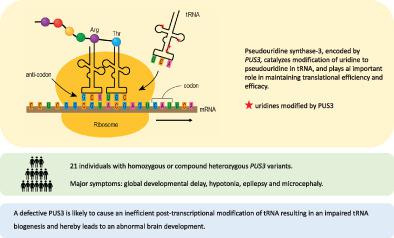当前位置:
X-MOL 学术
›
Clin. Genet.
›
论文详情
Our official English website, www.x-mol.net, welcomes your feedback! (Note: you will need to create a separate account there.)
Clinical and molecular delineation of PUS3-associated neurodevelopmental disorders
Clinical Genetics ( IF 3.5 ) Pub Date : 2021-08-20 , DOI: 10.1111/cge.14051 Miriam Nøstvik 1 , Sarah M Kateta 1 , Bitten Schönewolf-Greulich 1 , Alexandra Afenjar 2 , Magalie Barth 3 , Felix Boschann 4 , Diane Doummar 5 , Tobias B Haack 6, 7 , Boris Keren 8 , Ludmila A Livshits 8, 9, 10 , Davide Mei 11 , Joohyun Park 6 , Tiziana Pisano 11 , Clement Prouteau 3 , Muhammad Umair 12, 13 , Ahmed Waqas 14 , Alban Ziegler 3 , Renzo Guerrini 11 , Rikke S Møller 15, 16 , Zeynep Tümer 1, 17
Clinical Genetics ( IF 3.5 ) Pub Date : 2021-08-20 , DOI: 10.1111/cge.14051 Miriam Nøstvik 1 , Sarah M Kateta 1 , Bitten Schönewolf-Greulich 1 , Alexandra Afenjar 2 , Magalie Barth 3 , Felix Boschann 4 , Diane Doummar 5 , Tobias B Haack 6, 7 , Boris Keren 8 , Ludmila A Livshits 8, 9, 10 , Davide Mei 11 , Joohyun Park 6 , Tiziana Pisano 11 , Clement Prouteau 3 , Muhammad Umair 12, 13 , Ahmed Waqas 14 , Alban Ziegler 3 , Renzo Guerrini 11 , Rikke S Møller 15, 16 , Zeynep Tümer 1, 17
Affiliation

|
Biallelic variants in PUS3 have recently been recognized as a rare cause of neurodevelopmental disorders. Pseudouridine synthase-3 encoded by PUS3 is an enzyme important for modification of various RNAs, including transfer RNA (tRNA). Here we present the clinical and genetic features of 21 individuals with biallelic PUS3 variants: seven new and 14 previously reported individuals, where clinical features of two were updated. The clinical and genetic information were collected through collaborations or by literature search. All individuals were characterized by the local clinicians and the gene variants were identified by next generation sequencing (NGS) based methodologies. The clinical picture was dominated by global developmental delay, epilepsy, hypotonia and microcephaly. Gray sclera, which has previously been suggested to be a characteristic feature of PUS3-associated phenotypes, was reported in only seven individuals. The patients had some dysmorphic facial features, but a recognizable gestalt was not observed. In conclusion, homozygous and compound heterozygous PUS3 variants lead to a rare neurodevelopmental disorder. Further functional studies are necessary to understand involvement of PUS3 and tRNA biogenesis in normal and abnormal brain development.
中文翻译:

PUS3相关神经发育障碍的临床和分子描述
PUS3 中的双等位基因变异最近被认为是神经发育障碍的罕见原因。由PUS3编码的 Pseudouridine synthase-3是一种对修饰各种 RNA 很重要的酶,包括转移 RNA (tRNA)。在这里,我们介绍了 21 名双等位基因PUS3个体的临床和遗传特征变体:7 个新个体和 14 个先前报告的个体,其中两个的临床特征被更新。通过合作或文献检索收集临床和遗传信息。所有个体均由当地临床医生进行表征,并通过基于下一代测序 (NGS) 的方法鉴定基因变异。临床表现以整体发育迟缓、癫痫、肌张力减退和小头畸形为主。以前曾被认为是PUS3相关表型的特征性特征的灰色巩膜仅在 7 个人中被报道。患者有一些畸形的面部特征,但没有观察到可识别的格式塔。总之,纯合子和复合杂合子PUS3变异导致罕见的神经发育障碍。需要进一步的功能研究来了解 PUS3 和 tRNA 生物发生在正常和异常大脑发育中的作用。
更新日期:2021-10-07
中文翻译:

PUS3相关神经发育障碍的临床和分子描述
PUS3 中的双等位基因变异最近被认为是神经发育障碍的罕见原因。由PUS3编码的 Pseudouridine synthase-3是一种对修饰各种 RNA 很重要的酶,包括转移 RNA (tRNA)。在这里,我们介绍了 21 名双等位基因PUS3个体的临床和遗传特征变体:7 个新个体和 14 个先前报告的个体,其中两个的临床特征被更新。通过合作或文献检索收集临床和遗传信息。所有个体均由当地临床医生进行表征,并通过基于下一代测序 (NGS) 的方法鉴定基因变异。临床表现以整体发育迟缓、癫痫、肌张力减退和小头畸形为主。以前曾被认为是PUS3相关表型的特征性特征的灰色巩膜仅在 7 个人中被报道。患者有一些畸形的面部特征,但没有观察到可识别的格式塔。总之,纯合子和复合杂合子PUS3变异导致罕见的神经发育障碍。需要进一步的功能研究来了解 PUS3 和 tRNA 生物发生在正常和异常大脑发育中的作用。


























 京公网安备 11010802027423号
京公网安备 11010802027423号